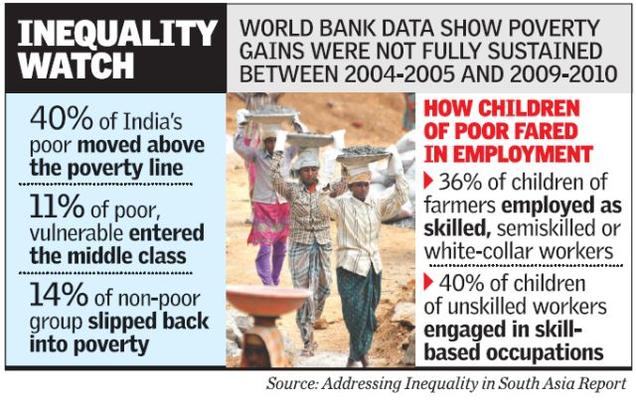Odds of Escaping Poverty in India, U.S. Same: World Bank
DEVELOPMENT, 26 Jan 2015
 21 Jan 2015 – A World Bank report has challenged the conventional understanding of India’s inequality. The report, “Addressing inequality in South Asia,” has found that the probability of a poor person moving out of poverty in India in 2014 was as good as that in the U.S.
21 Jan 2015 – A World Bank report has challenged the conventional understanding of India’s inequality. The report, “Addressing inequality in South Asia,” has found that the probability of a poor person moving out of poverty in India in 2014 was as good as that in the U.S.
“There is good news — India is no longer the land of extremes and there are some bright spots,” said Martin Rama, one of the authors of the report and World Bank Chief Economist for South Asia.
The report has found that sons from Scheduled Caste and Scheduled Tribe households are no longer stuck in the jobs done by their fathers. Across generations, mobility of occupational profiles among Muslims has been similar to that of higher caste Hindus, whereas mobility among Scheduled Castes and Scheduled Tribes and Other Backward Classes has become higher than that of upper caste Hindus over time.
The report shows that one of the main drivers of upward mobility is the increase in number of non-farm jobs in rural India.
Urbanisation reducing inequality: World Bank report
A World Bank report has found that between 2004-05 and 2009-10, 15 per cent of India’s population, or 40 per cent of the poor, moved above the poverty line. In the same period, a sizeable portion of the poor and the vulnerable — over 9 per cent of the total population or about 11 per cent of the poor and vulnerable — moved into the middle class.
However, over 9 per cent of the total population, or about 14 per cent of the non-poor group, slipped back into poverty, revealing the greater risks faced by the vulnerable and even the middle class than in other countries, the report, “Addressing inequality in South Asia,” said.
The third finding of the report that challenges the conventional understanding of inequality in India, said Onno Ruhl, World Bank Country Director in India, is that urbanisation is reducing inequality, not increasing it.
Mr. Ruhl said the policy takeaways from the report for Prime Minister Narendra Modi included “strive for universal health and sanitation; leverage the opportunity for urbanisation; and create jobs for all and build skills not just through technical training but also with servicing the population with primary and secondary education and nutrition.”
DISCLAIMER: The statements, views and opinions expressed in pieces republished here are solely those of the authors and do not necessarily represent those of TMS. In accordance with title 17 U.S.C. section 107, this material is distributed without profit to those who have expressed a prior interest in receiving the included information for research and educational purposes. TMS has no affiliation whatsoever with the originator of this article nor is TMS endorsed or sponsored by the originator. “GO TO ORIGINAL” links are provided as a convenience to our readers and allow for verification of authenticity. However, as originating pages are often updated by their originating host sites, the versions posted may not match the versions our readers view when clicking the “GO TO ORIGINAL” links. This site contains copyrighted material the use of which has not always been specifically authorized by the copyright owner. We are making such material available in our efforts to advance understanding of environmental, political, human rights, economic, democracy, scientific, and social justice issues, etc. We believe this constitutes a ‘fair use’ of any such copyrighted material as provided for in section 107 of the US Copyright Law. In accordance with Title 17 U.S.C. Section 107, the material on this site is distributed without profit to those who have expressed a prior interest in receiving the included information for research and educational purposes. For more information go to: http://www.law.cornell.edu/uscode/17/107.shtml. If you wish to use copyrighted material from this site for purposes of your own that go beyond ‘fair use’, you must obtain permission from the copyright owner.